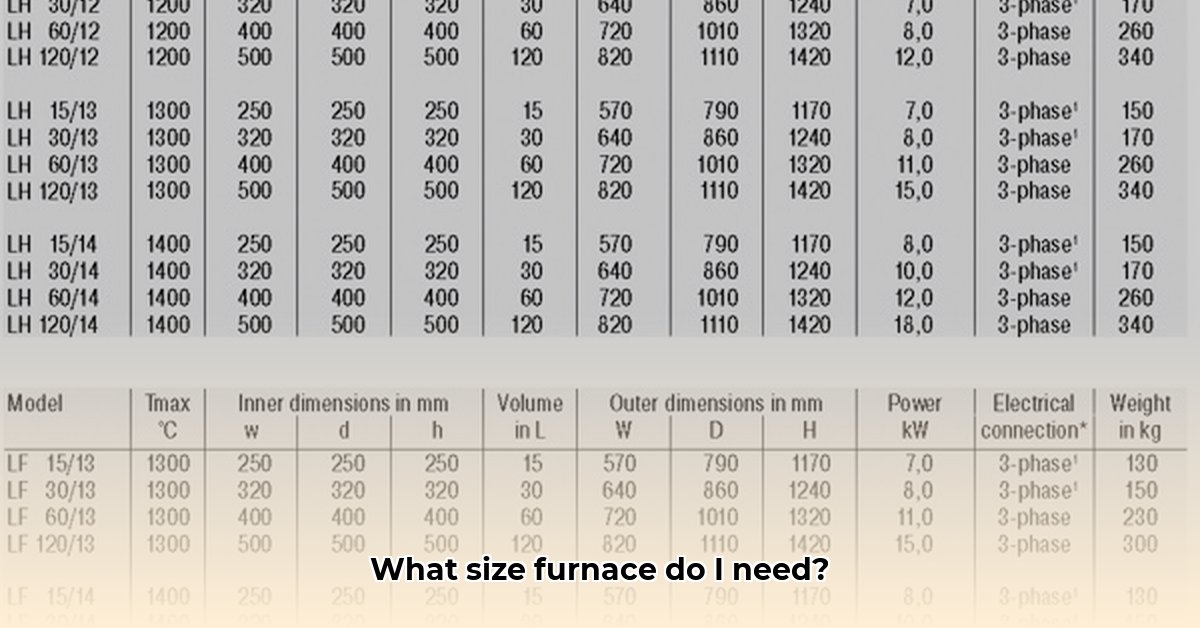Is your house too hot in the summer and too cold in the winter? Are your heating bills through the roof? You might have the wrong size furnace. This guide, along with practical examples, will help you find the perfect furnace for your home. We’ll walk you through everything you need to know, from understanding how factors like house size, climate, and insulation affect furnace size, to using a calculator and interpreting the results. Let’s find the right furnace to keep your home cozy and your wallet happy.
Why Furnace Size is Crucial
An incorrectly sized furnace can lead to several problems:
- Discomfort: An undersized furnace struggles to heat your home, leaving you shivering in winter. An oversized furnace, on the other hand, cycles on and off rapidly, creating temperature fluctuations and potentially leaving you sweating one minute and freezing the next.
- Wasted Energy & Higher Bills: Both undersized and oversized furnaces are energy hogs. A too-small furnace runs constantly, while a too-large one wastes energy during short cycles. This translates directly into higher utility bills.
- Equipment Failure: Constant strain wears down an undersized furnace prematurely. Short cycling causes excessive wear and tear on components in an oversized furnace, both leading to costly repairs and a shorter lifespan.
Factors Affecting Furnace Size
Several factors determine the right furnace size for your home:
- Climate: Colder climates require more powerful furnaces. A home in Maine needs a significantly larger furnace than a comparable home in Georgia. Climate zone maps (like those available from Energy.gov) can help determine your specific zone.
- Square Footage: Larger homes generally require more BTUs (British Thermal Units, a measure of heat output) to heat effectively. This is often the starting point for furnace size calculations, but it’s not the only factor.
- Insulation: Good insulation reduces heat loss. Well-insulated homes might need smaller furnaces than poorly insulated ones with equivalent square footage. Look for R-values on your existing insulation to assess its effectiveness.
- Sunlight (Solar Gain): South-facing windows can capture significant solar heat, potentially reducing your furnace’s workload.
- Home Age: Older homes often have less effective insulation and more air leaks, which can increase heating demands.
- Ceiling Height: Higher ceilings mean more air to heat, possibly calling for a more powerful furnace.
- Windows: Windows are a significant source of heat loss. The type, size, and number of windows in your home play a role in determining the furnace size. Double-pane, energy-efficient windows reduce heat loss compared to single-pane windows.
- Air Leaks: Small cracks and gaps around windows, doors, and other areas can significantly impact energy efficiency. Sealing these leaks can reduce the load on your furnace.
Understanding BTUs and the Calculation
BTUs measure a furnace’s heat output per hour. While the precise calculation can be complex, there are simplified methods:
Simplified Method (Square Footage and Climate Zone): Multiply your home’s square footage by a BTU-per-square-foot factor based on your climate zone (see table below).
| Climate Zone | BTU/sq ft (Approximate) |
|---|---|
| 1 (Warmest) | 30-35 |
| 2 | 35-40 |
| 3 | 40-45 |
| 4 | 45-50 |
| 5 | 50-60 |
| 6 (Coldest) | 60+ |
Example: A 2,000 square-foot home in Zone 3 might need approximately 80,000 to 90,000 BTUs.
More Precise Calculation: A qualified HVAC technician will likely use a Manual J load calculation, which considers all heat loss factors for a more accurate result.
Using a Furnace Size Calculator: Step-by-Step
- Find a Reputable Calculator: Look for calculators from HVAC companies, government energy sites (Energy.gov), or reputable home improvement resources.
- Gather Information: Collect your home’s square footage, climate zone, insulation R-values, window details, and other relevant information. Accuracy is key for reliable results.
- Input Data: Carefully enter your information into the calculator. Double-check for errors.
- Interpret Results: The calculator will provide a BTU range. Remember, this is a starting point.
Interpreting Results and Next Steps
Once you have a BTU range, consult with a qualified HVAC professional. They can:
- Perform a Manual J Calculation: This provides a precise heating load calculation tailored to your home.
- Assess Your Ductwork: Proper ductwork ensures efficient heat distribution.
- Consider Ventilation: Balanced ventilation is crucial for healthy indoor air quality.
- Recommend Specific Models: They can suggest furnaces that meet your needs and budget.
Furnace Efficiency and Advanced Considerations
- AFUE Rating: The Annual Fuel Utilization Efficiency (AFUE) rating measures how effectively a furnace converts fuel to heat. Higher AFUE ratings mean greater efficiency and lower operating costs. Look for furnaces with AFUE ratings of 90% or higher.
- Variable-Speed Furnaces: These furnaces adjust their output based on demand, providing consistent temperatures and potentially saving energy.
- Smart Thermostats: Programmable and smart thermostats can optimize your heating schedule and further enhance efficiency.
- Zoning Systems: Zoning allows you to control the temperature in different areas of your home independently, providing greater comfort and potentially reducing energy waste.
Related Topics
- Alternative Heating: Explore options like heat pumps, which offer both heating and cooling.
- Furnace Maintenance: Regular maintenance, including filter changes and inspections, is essential for safety, efficiency, and longevity.
- Indoor Air Quality: Consider air filters, purifiers, and ventilation strategies to improve your home’s indoor air quality.
Disclaimer
This information is for general guidance only. Consult with a qualified HVAC professional for personalized advice and furnace installation. While online resources offer helpful information, they cannot replace the expertise of a trained professional. A professional assessment is essential to ensure proper furnace sizing and installation.
- How to Stop Apps From Running in the Background to Boost Your - December 1, 2025
- How To Move Apps On Your Droid For Better Organization - November 30, 2025
- How to Move Apps on Android for Better Organization - November 29, 2025










